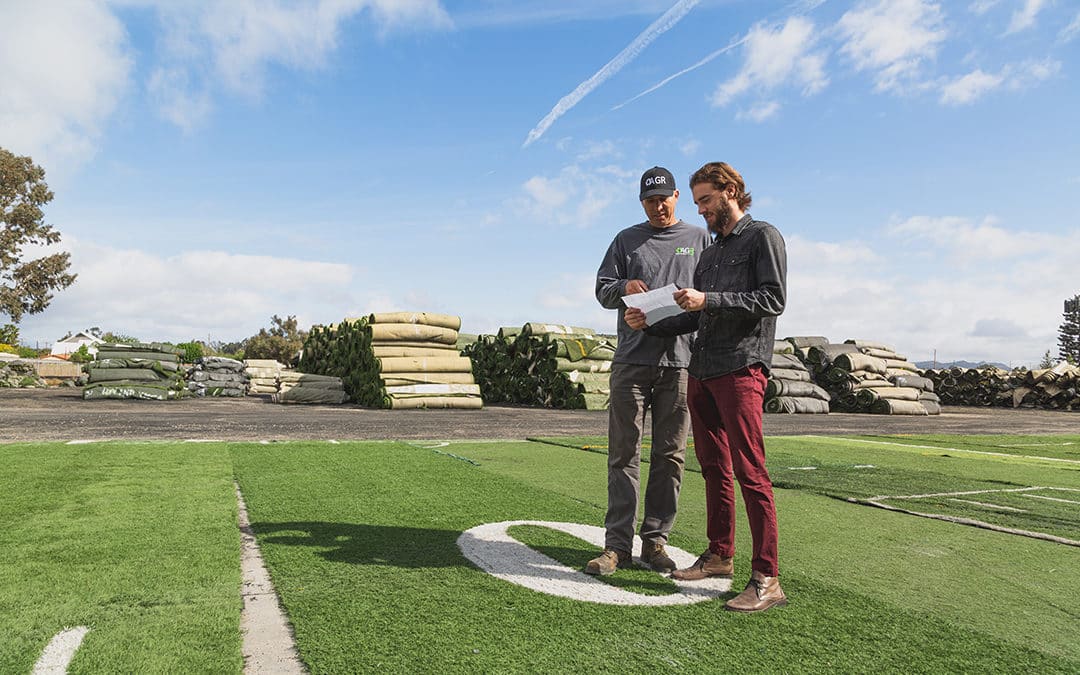What You’ll Need
Pickax
Shovel
Rake
Push broom
Turf paint
Hammer
Mallet
40-D turf nails
Spackle
Box cutter
Putty Knife
Turf Glue
Seam Tape
Drop Spreader
Getting Started
01. Remove Grass
Remove your existing lawn and base, and then dispose of it according to local regulations. Soil builds up quickly, so we recommend having a dump trailer onsight.
You’ll want to remove about 1.5 inches – 2.5 inches of soil, so that your artificial turf can sit half an inch higher than any edging.
Level the area using a shovel to remove any bumps, rocks, or sticks. Rake the area once you’ve removed large debris and consider watering the surface for a nice finish.
02. Cap Sprinkler Heads
Once you’ve cleared the existing groundcover, remove and cap all sprinkler heads.
03. Add Base
Next, evenly spread three inches of class II road base over the area where you will be laying your turf. Road base will help us to create a level platform with proper drainage.
Lightly wet the area and compact it to create a smooth base for laying the material.
Depending on your yard, you may want to add gopher wire and weed barrier to prevent vegetation and pests from sprouting through your new lawn. Weed barrier is NOT recommended if you have pets.
04. Weed Barrier
To protect your turf, we recommend laying a sheet of a weed suppressant over the surface space on which you are installing your turf.
If your yard has unique corners or curves, carefully shape the suppressant using a utility knife.
05. Lay Turf
Next is the part we’ve all been waiting for… It’s time to lay your brand new turf!
When you measure out the amount of turf that you’ll use for your yard, we recommend giving yourself a bit of extra turf to work with on all sides. You wouldn’t want to come up short, and you can always trim away the extra.
As you roll out your gorgeous new lawn, be careful not to let it drag across your freshly prepared base. We recommend letting grass sit in the sun for 30-60 minutes to expand. Make sure that the blades and stitch patterns are all facing the same way. Ignoring this would result in a poor looking lawn.
Use a carpet kicker to stretch and maneuver the turf into place.
06. Cut to Fit
Next, use a box cutter to fit your new lawn to the unique shape of your yard. All cuts should be made from the back of your turf so you can see the stitch rows. Leave a quarter to half an inch of turf over the border to help with finishing touches.
Then secure the seams using seam tape and glue. Correctly fitting the seams together is essential to creating a pristine, natural looking yard. Make sure that the blades of each piece of turf are oriented the same way, and that space in between stitch rows match.
Place the red line of the seam tape squarely in the center of the seam. Then create an “S” pattern with the glue on each side of the red line. Move the turf into place and let the glue set.
07. Secure the Perimeter
After tucking in the border with a putty knife and hammer, place 40-D 5 inch non-galvanized turf nails every six inches to secure your turf to its three inch base.
If you have any existing holes or tears they can easily be repaired by securing the loose turf with a few nails.
We recommend also placing a handful of nails along the seams to reinforce these areas. Then brush the turf with a power or push broom to stand the blades up straighter BEFORE adding infill. This will create a more vertical blade memory.
08. Cover Lines
Use green paint to cover up any unwanted lines or markings.
09. Spread Infill
Next it’s time to spread the infill! Adding the correct amount of infill will directly impact the appearance, performance, and life span of your lawn. Use a drop spreader to evenly disperse the proper amount of infill.
We recommend adding two pounds of infill per square foot.
10. Brush Infill
Once the infill is in place, use a power or push broom to brush the turf. This will stand the blades up straight and give your new lawn the appearance of freshly mowed grass. Lastly, rinse the grass to get rid of all remaining dust.
11. Enjoy Your Lawn
Once you’ve rinsed your lawn and packed up your equipment, all that’s left to do is kick back, relax, and enjoy your brand new turf! You won’t have to worry about getting up early to mow ever again. The only necessary maintenance is brushing your lawn a couple times each year.

